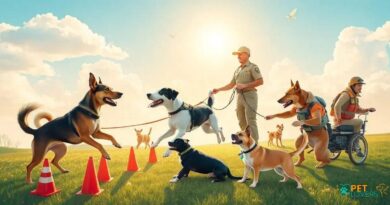What is Learning tricks
What is Learning Tricks?
Learning tricks refers to the process of teaching dogs various behaviors or actions that are not only entertaining but also serve to strengthen the bond between the pet and its owner. This practice can involve simple commands like “sit” or “stay,” as well as more complex tricks such as rolling over or playing dead. The essence of learning tricks lies in the positive reinforcement techniques that encourage dogs to repeat desired behaviors, making training a fun and rewarding experience for both parties.
The Importance of Learning Tricks
Teaching your dog tricks is not just about impressing friends or family; it plays a crucial role in your dog’s mental stimulation and overall well-being. Engaging in trick training helps to keep your dog’s mind sharp and focused, reducing the likelihood of behavioral issues stemming from boredom. Additionally, learning tricks can enhance your dog’s obedience and responsiveness, making everyday interactions smoother and more enjoyable.
Basic Techniques for Teaching Tricks
When it comes to teaching tricks, consistency is key. Start with basic commands and gradually introduce more complex tricks as your dog becomes more comfortable. Use positive reinforcement methods, such as treats, praise, or playtime, to reward your dog for successfully completing a trick. This approach not only motivates your dog but also fosters a positive learning environment where your pet feels safe and encouraged to try new things.
Common Tricks to Teach Your Dog
Some of the most popular tricks to teach dogs include “shake hands,” “roll over,” “play dead,” and “spin.” These tricks can be taught using similar methods, focusing on breaking down each trick into smaller, manageable steps. For instance, to teach “roll over,” you might first get your dog to lie down, then gently guide them to roll onto their side, rewarding them at each stage until they can complete the full trick.
Using Clicker Training for Learning Tricks
Clicker training is a highly effective method for teaching tricks to dogs. This technique involves using a small device that makes a clicking sound to mark the exact moment your dog performs the desired behavior. The sound of the click is followed by a reward, which helps the dog associate the action with positive reinforcement. Clicker training can accelerate the learning process and improve the accuracy of your dog’s responses.
Challenges in Learning Tricks
While teaching tricks can be a fun experience, it can also come with its challenges. Some dogs may be more stubborn or easily distracted than others, making it difficult to maintain their focus during training sessions. It’s essential to be patient and adaptable, adjusting your training techniques to suit your dog’s unique personality and learning style. If a particular trick proves too challenging, consider breaking it down further or taking a break before revisiting it.
Incorporating Tricks into Daily Life
Learning tricks can seamlessly integrate into your dog’s daily routine, providing both mental and physical stimulation. Incorporate trick training into your walks, playtime, or even during mealtime by asking your dog to perform a trick before receiving their food. This not only reinforces the learning process but also adds an element of fun to everyday activities, keeping your dog engaged and eager to learn.
The Benefits of Learning Tricks Beyond Entertainment
Beyond the obvious entertainment value, learning tricks can have numerous benefits for both dogs and their owners. It can improve communication between you and your pet, as you learn to understand each other’s cues and signals better. Additionally, trick training can enhance your dog’s social skills, making them more confident and well-adjusted in various environments, whether at home or in public settings.
Continuing Education for Dogs
Learning tricks should not be a one-time event; it can be a lifelong journey for both you and your dog. As your dog masters certain tricks, consider introducing new ones or even enrolling in advanced training classes. This ongoing education not only keeps your dog mentally stimulated but also strengthens the bond you share, creating a deeper connection built on trust and mutual respect.



